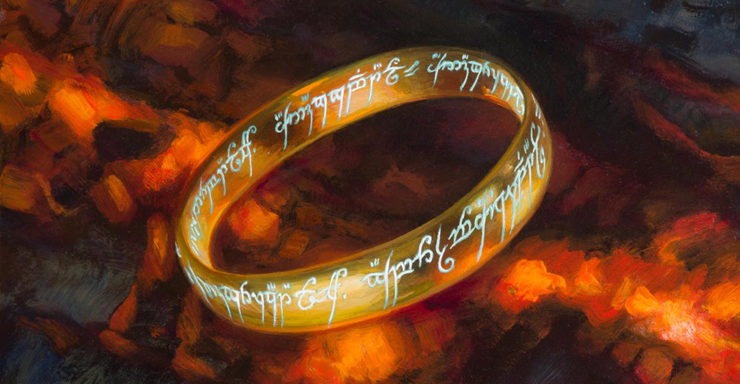Wherein Sauron Hoodwinks the Elves, Forges His Trusty Ring, Unveils His New Tower, and Then, Having Had It Up to Here With All That Nonsense, Men and Elves Form the Last Alliance
The final section of The Silmarillion, “Of the Rings of Power and the Third Age” is basically the bridge between the Quenta, the downfall of Númenor, and The Lord of the Rings, even summarizing the high-level events of the War of the Ring. I’m sure anyone reading this Primer will already be well acquainted with that last event. Given the overlap in exposition between this section and The Lord of the Rings itself, I’m going to tie things together with Appendix B: The Tale of Years from Tolkien’s most famous book…with a dash and a few dollops from Unfinished Tales.
Think of all this as proper stage setting for a reread of The Lord of the Rings. Now, this section is jam-packed with exposition, so I’m going to separate it into halves (one last time). But first, let’s recalibrate: We need to jump back to the start of the Second Age, long before the fall of Númenor.
Dramatis personæ of note:
- Sauron – Maia, Lord of the Earth, real estate tycoon, full-fledged asshole
- Gil-galad – Noldo, High-King of the Noldor
- Elrond – Half-elven, herald of Gil-galad, advisor
- Celebrimbor – Noldo, jewel-smith extraordinaire, grandson of Fëanor
- Elendil – Man, Númenor survivor, tall and Faithful king of the Dúnedain
- Isildur – Man, Elendil’s kid, White Tree porter
Of the Rings of Power…
If it wasn’t for Sauron, things might have been peachy—eh, peachy enough—for a long time. Yeah, Morgoth having tainted the world means there are still monsters and evil Men doing their thing, but they’d have stayed divided. And yeah, the Númenóreans would still eventually turn from benefactor Sea-Kings to tribute-demanding bullies, and Ar-Pharazôn would have gone unchecked (as covered in the previous installment). Yet without Sauron pushing the king into waging war with the Valar, Númenor might have endured and so, too, would the Faithful. There’d have been a lot more time for them to turn things around and do good for the world, ennobling others as the Valar and the Eldar had ennobled them.
Sauron, meanwhile, had the opportunity at the end of the War of Wrath to repent for his service to Morgoth. And for his many terrible crimes—not the least of which was sending the werewolf that killed Finrod Felagund, the swellest Elf that Middle-earth ever had the privilege to know. But hey, whatever. I’m over it.
Of all of Morgoth’s servants, Sauron the Deceiver is the most subtle, the most crafty, and certainly the most powerful. Whenever one of the other heavyweights like Gothmog showed up, they just smashed, burned, and pounded folks. And while Sauron would rather dominate everyone with raw power, he knows you can catch more Elven-flies with honey; he’s been a master of phantoms and shadows since the First Age. He’s got more than a few white lies and taradiddles tucked away.
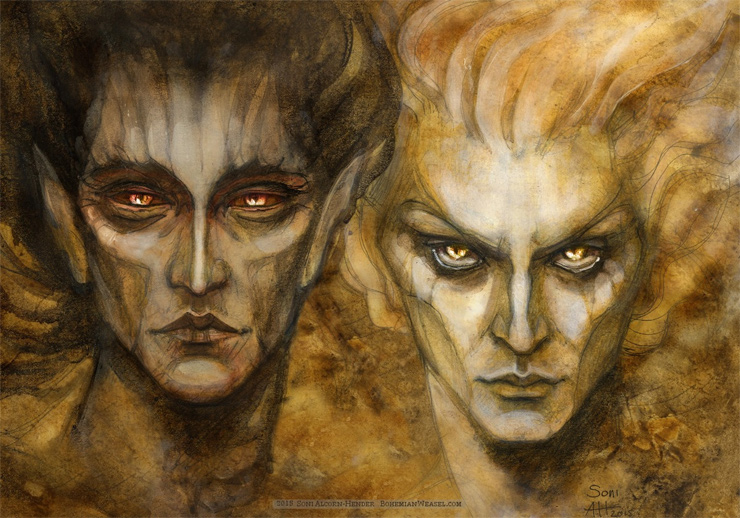
But here’s the thing about Sauron: He almost wasn’t. Yes, he was seduced by Melkor long ago, but he wasn’t necessarily bad since the word “Eä!” In fact, in those very olden days he was a Maia in service to Aulë and thus had a proclivity for the substance of Arda, for making things, for being…well, yeah, crafty. But somewhere along the way—and we’re not sure how or when—Melkor convinced him that his was going to be the winning side. So he hopped on over to Team Melkor and did his master’s work. (Had he helped throw down the Lamps of the Valar? Maybe.) Then, a bajillion years later, when Melkor was finally removed by the Valar and tossed out into the Void, Sauron was rightly intimidated. He repented, we’re told, if only out of fear and not because he felt bad about doing any of the shit he did.
So while the surviving Balrogs scuttled away and hid, Sauron came forth to apologize to Eönwë right there in sinking Beleriand. And the herald of Manwë was like, “Awesome. But I can’t forgive you. Go tell the Valar what you told me, face their judgement, and we’ll be fine.” But Sauron was too ashamed to confront Manwë’s, probably Varda’s, and almost certainly Mandos’s judgmental faces. And what if—crap—Tulkas wanted a piece of him, too? So he decided it wasn’t worth it, he’d take his chances on Middle-earth and lay low. Only to become, centuries into the Second Age, the new Dark Lord.
So, to quote a certain Englishman:
Meet the new boss
Same as the old boss
Well, not exactly! Aside from differing MOs, one overarching distinction between Morgoth and Sauron is their endgames; this is expounded upon wonderfully in the book Morgoth’s Ring. Everything Morgoth did was aimed at destroying all that Ilúvatar and the Valar had made. He wanted it all gone, even his own Orcs and monsters, who were all just a means to an end. He wanted it all wiped clean so he could create his own world and his own people. Whereas Sauron is perfectly fine with Arda as is. No need to unmake it. But. BUT. He needs to be the one to rule it, to order all things as he desires. At the end of the day, Sauron is Lawful Evil; he likes structure. His structure.
Buy the Book
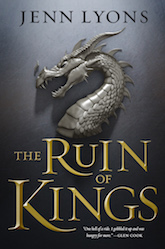

The Ruin of Kings
To that end, he needs to quell all opposition. Men he can push around thanks to all of Morgoth’s groundwork—well, except for those upstart Númenóreans. They will need some special attention. Yes, those Dúnedain have an irritating talent for disrupting his arrangements. And those Noldorin Elves and their Sindarin friends up in the northwest corner of Middle-earth…have become a nuisance. Sauron sure hopes they will meet with a little accident, i.e. be deliberately killed to death.
Now, Lindon is where Gil-galad has settled, and as the latest High King of the Noldor, he’s in charge. Granted, as his first cousin once removed (the cousin of his dad), Galadriel is “young” Gil-galad’s elder; she’s no doubt much wiser than he, too. But with her husband, the Sinda Celeborn, Galadriel is content to remain in an advisory capacity for now—her Lothlórien days are coming soon enough. Other Elf luminaries in attendance include the son of Eärendil, Elrond Half-elven; Celebrimbor, grandson of the legendary/terrible Fëanor; and Círdan the mofo Shipwright, who oversees the port of Mithlond, better known as the Grey Havens.
It’s from the Grey Havens that the Elves enjoy an open invitation from the Valar to sail by the Straight Road to the Undying Lands, should they become weary of the darkness of the world. And we know from The Lord of the Rings that over time, Elves will continue to trickle west, reach the Havens, and then leave Middle-earth for good. Even if it was a mistake for the Valar to summon the Elves to Valinor that first time long ago, it’s clear to all that the Firstborn are waning now—have been, for some time. And so the Elves who are still choosing to tarry are doing so on borrowed time.
These are the holdouts. Elves who (a) love these lands too much, (b) still desire to make realms of their own quite apart from the greater glory of the Valar, or (c) simply do not wish to leave Middle-earth’s people to its new troubles. They’re a mixed batch, and their reasons for staying are complex. As a reminder of what people we’re talking about…
- Noldor – Formerly exiled Calaquendi, or at least have parents who had seen the Light of the Trees
- Sindar – Formerly the Teleri, those who had once headed for Valinor but decided to stay in Beleriand
- Silvan Elves – Formerly the Nandor, and also known as Woodland Elves or Wood-elves (in The Hobbit)
The Noldor set themselves up in realm they call Eregion (eh-REG-ee-on) in Eriador, whose chief city is Ost-in-Edhil (OST-in-ETH-il). And while it’s suggested elsewhere that Galadriel and Celeborn dwell here for a long time and may even be its first rulers, Celebrimbor is really the one who goes down in history as its lord.
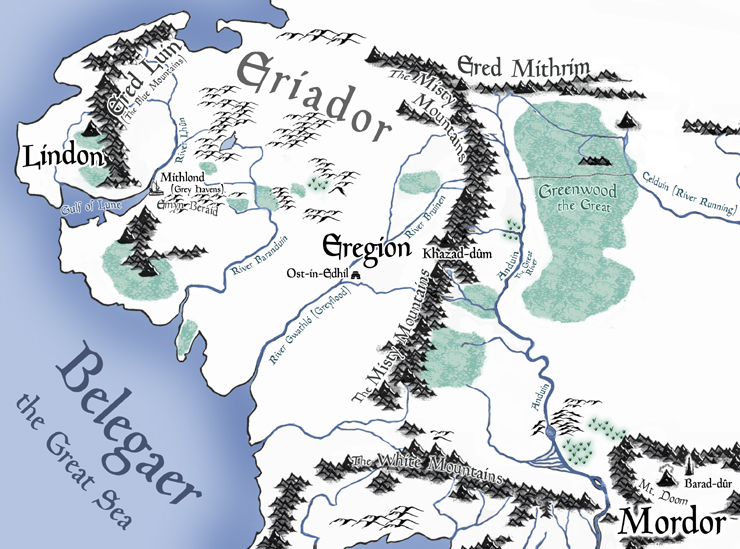
The Noldor who dwell there really embody the artistry of their kindred, owing to their lord’s own talent and heritage. The grandson of the makers of the Silmarils has some serious crafting cred just by who he is—and it helps that he’s got none of his grandpop’s arrogance and douchebaggery. He’s a good guy; he just wants to make stuff! He even founds a sort of Elf-guild called the Gwaith-i-Mírdain, which literally means “brotherhood of Jewel-smiths” in Sindarin.
Now, Eregion’s eastern border is right up against the Dwarf kingdom of Khazad-dûm (future Moria), and they get along well with each other. And why not? Both the Noldor and the Dwarves give mad props to Aulë; some of the former might have actually spent time in his company, and all of the latter were made by him. Win-win. So there is friendship and commerce between Elves and Dwarves, and a general hand-waving away of any past grievances. (I’m looking at you, Dwarves of Nogrod and Sindar of Doriath!)
These are the “happier times” Gandalf is referring to when he solves the riddle of Moria’s West-gate more than four thousand years later. These are the times when all you had to do was say the Sindarin word for “friend” to enter your neighbor’s side door; you could leave your keys in your car, and you could make your email password the actual word “password.” Good times!
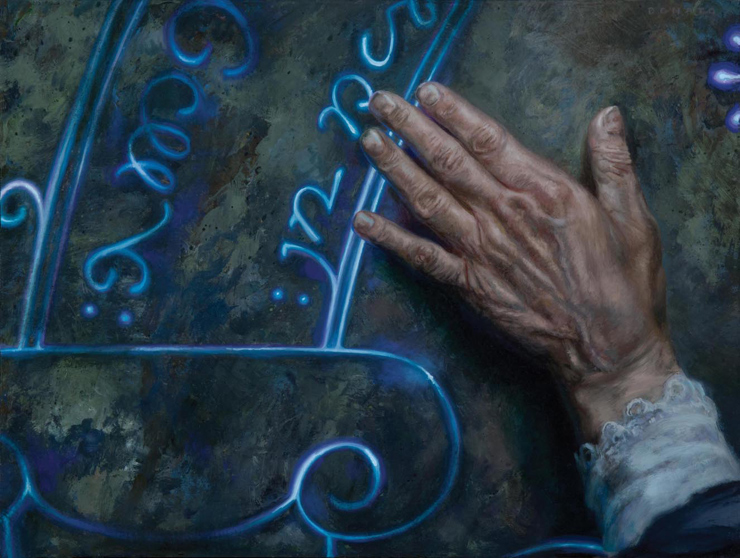
But it can’t last forever, can it? Because Sauron apprenticed with the Dark Enemy of the World and he’s ready to get sneaky and mess with all their stuff. It’s around the year 500 of the Second Age that he rises from obscurity and starts to gather evil things into his fold. Gradually, Gil-galad becomes aware of a hostile and mighty spirit, but not necessarily its identity. He warns the visiting Númenóreans about it—this being back when the Númenóreans were still friends. After a while, those Dúnedain stop visiting altogether and don’t even write.
Then, roundabout the year 1000, Sauron moves into his new neighborhood, Mordor, the Black Land. (Shelob, hipster that she is, had moved into Mordor before it was cool.) Conveniently in this land is the volcano Orodruin, a.k.a. Mount Doom, whose fires are so hot that it’s the perfect forge for this former student of Aulë’s to tool around in and maybe take up a hobby. Like the Misty Mountains and no doubt many other “messed up” or imposing geological features of Middle-earth, Mount Doom was reared by Melkor in ages past.
And it’s in this inhospitable land of hollows, fumes, and shadows that Sauron begins construction of his headquarters of Barad-dûr in the broad valley of Gorgoroth.
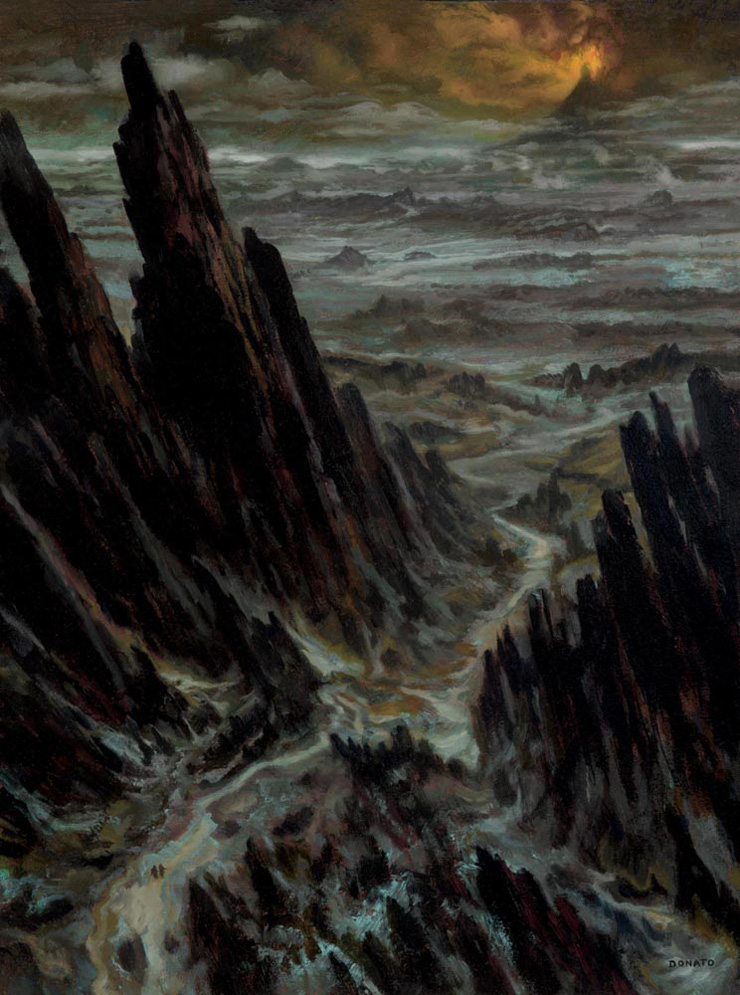
Now remember, this is all well before Ar-Pharazôn’s day. When Men eventually get uppity, Sauron will know how to play them. They desire power, and he can simply go forth with his own name and trip them up with creepy counsel. But with the Elves, that’s not gonna do it. He’s got to play his cards just right, conceal his real hand. They’re immortal, like him; they remember Morgoth himself. But that doesn’t mean they’re well acquainted with Morgoth’s old sidekick, Sauron, who even in the service of the first Dark Lord seems to have flown mostly under the radar.
As near as I can tell, it’s when Sauron took over Finrod’s island-tower of Tol Sirion and then renamed it the Isle of Werewolves that the Elves of Nargothrond really got to know him. But since the fall of Nargothrond and the death of most of its residents, Sauron’s name might have gone back into obscurity even among the Eldar. Who knows? There are some solid loremasters here in the Second Age that know, at least, to be wary of the legacy of Morgoth. In any case, he knows better than to go before these Elves in some gothed-up suit of black armor bearing his own Elf-branded name of Sauron, “the Abhorred.”
So he invents Annatar, a charismatic guise of comely appearance, and then goes among them, presenting himself as the Lord of Gifts. We’re not given any details, but he probably looks much like an Elf, just as Melian had clothed herself in such a fair form. Elves are used to seeing Maiar and Valar alike assume such shapes, so it’s not likely they’d mistake him for just someone’s heretofore distant relative.
Now, this book offers no detail, but Unfinished Tales gives us a bit of lore about this shape, which seems consistent enough with the Silmarillion text. For example, it says it is a “specious fair form” that was “posed as an emissary of the Valar, sent by them to Middle-earth (‘thus anticipating the Istari’) or ordered by them them to remain there to give aid to the elves.” Of course, in that version of events, Sauron also sees Galadriel as his primary adversary—and sadly, there’s just nothing on that in the published Silmarillion.
In any case, not all the Elves believe him. Gil-galad and Elrond, notably, don’t trust Annatar and actually refuse to allow him in Lindon at all. They even send out messengers to other places where Elves have settled, warning them against trusting this guy. But, sadly, others ignore the warnings and listen intently to Annatar. Especially the Noldor of Eregion. He’s both fair and wise, this Annatar fella, and they like what he has to say. He doesn’t gainsay the Valar, or Ilúvatar, or use any of the bald-faced lies he’ll later hock up on Númenor.
Rather, he appeals to both their longing for Valinor and their affection for Middle-earth. He doesn’t offer them immortality or personal power—they’ve already got that—but influence over the land itself. Basically: “Hey, you know how cool Middle-earth is, but maybe a little too dim, a little too ordinary? Why not make this continent as fair and timeless as Eressëa itself, or even Valinor proper? I, for one, think there’s a reason you haven’t returned to Aman when your exile ended, and it’s because you still love this land. I get that—I love it, too! It’s a shame Gil-galad and Elrond don’t see the possibilities. But you can. Let me help you make Middle-earth better than it is, and in doing so we can raise up all Elfkind to the same level as those in Valinor. Help me help you.”
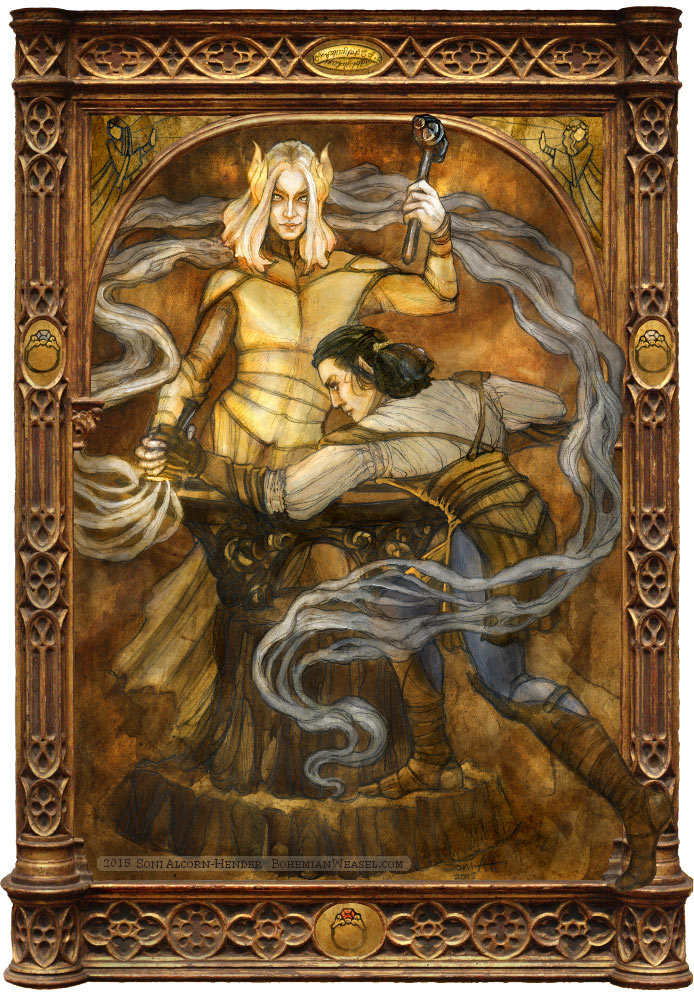
There’s obviously much more to the story, but this is all high-level synopsis material, anyway. It’s always good to remember that. I can well imagine Gil-galad sending out riders—the Elf equivalent of investigative journalists—to try to sniff out the truth about this so-called Lord of Gifts. He’s way too good to be true, right? He’s more than just a pretty face: he’s got mad skillz and a willingness to share his great knowledge. But as far as the Noldor of Eregion are concerned, this guy knows so much about crafting, he’s got to be one of Aulë’s own.
It is Celebrimbor, lord of Eregion and the one who counts the most at this pivotal point in history, who falls especially hard for Sauron’s ploy. He’s the heir of Fëanor and his little club of elite jewel-smiths, the Gwaith-i-Mírdain, are at the top of their game. Why not pool their resources, accept the masterful guidance of Annatar, and improve the world itself? Their outward intentions are good; it is their conflicted hearts that are being exploited. Tolkien himself explains this in a letter:
But they wanted to have their cake without eating it. They wanted the peace and bliss and perfect memory of ‘The West’, and yet to remain on the ordinary earth where their prestige as the highest people, above wild Elves, dwarves, and Men, was greater than at the bottom of the hierarchy of Valinor.
They know, as the Firstborn, that they’re only immortal for a limited time (the duration of Arda). They know they’re fading, as a race, and they will seize this chance to delay it.
And Sauron has dreamt up a way to ensnare them all with these dangerous desires. You might even say, to…bind them. He comes up with a project perfectly suited for their love of jewel-crafting. He’s smart.
I mean, would an imbecile come up with this design?

In truth, we’re not told who first thought of rings as the items of choice. Celebrimbor’s little arts and crafts club was all about making jewelry; it might have been one of those Noldor. But I suspect it was still Sauron’s own idea to go with rings, since it is he who comes up with the formula that would tether all their power into one secret ring. But at first it’s just a bunch of minor rings the Elven-smiths make—and heck, those are mere “essays in the craft before it was full grown” that might well have preceded Annatar’s coming. (Still, they’re nothing to sneeze at; think of Fëanor’s side projects, the now-treasured palantíri!)
But it’s under Sauron’s mentorship that Celebrimbor and the smiths up their game and start forging the Rings of Power! Now, despite the memorable phrasing of the verse “long known in Elven-lore,” it’s worth noting that three rings weren’t made for Elven-kings, nor seven made for Dwarf-lords, and certainly not nine intended for mortal Men. At least, that wasn’t Sauron’s sales pitch to the Elven-smiths. In fact, Gandalf tells Frodo in Fellowship that even the least of the rings made by the Elves would be perilous to mortals. Rather, they were ostensibly all for the Elves alone, to use to enrich Middle-earth.
So now it’s around the year 1500, and the creation of exactly sixteen Rings of Power begins with Annatar/Sauron in attendance—under his scrutiny and using his specs. This is important, because all sixteen will subject their future wearers to his direct influence and corruption. And these Rings of Power are not made overnight; they are the labor of years. Then Sauron heads back to Mordor, and probably not while they’re watching him—he’s just Annatar, after all, simply taking his leave for a while. He’s, uhh, got something to do…and so he leaves them to their work. (Hey, Barad-dûr isn’t going to complete itself!)
When the sixteen are finished, they’re kept right there in Ost-in-Edhil, where they were made. They’re not divvied out to anyone right away. When have Elves ever hurried to do anything?
At some point, Celebrimbor alone sets to work on three more Rings of Power, rings that Sauron never touched or got to micromanage—and these, of course, are the Three. Where his grandfather wrought the three Silmarils as his singular best work, Narya, Nenya, and Vilya are Celebrimbor’s own magna opera. Ninety years after the start of the other sixteen, he completes them. In addition to being just as powerful as those earlier rings, these three can be used to “ward off the decays of time and postpone the weariness of the world.” Being himself pure in heart (if naïve as hell), Celebrimbor, like a Noldo of old from the Bliss of Valinor days, gives away all his wonderful new objets d’art. How opposite Sauron can you be?
But yeah, just because he made them doesn’t mean Celebrimbor believes he ought to wield them. He gives Narya, the Ring of Fire, to Gil-galad, who promptly regifts it to Círdan. Nenya, the Ring of Water, he gives to Galadriel. And Vilya, the Ring of Air, also goes from Gil-galad to Elrond in due time. That’s just the sort of Elves these are.
But Sauron doesn’t know about the Three, at least not yet. See, he’s a bit busy in Mordor, working hard in his volcano-foundry and putting the final touches on his own band of metal.
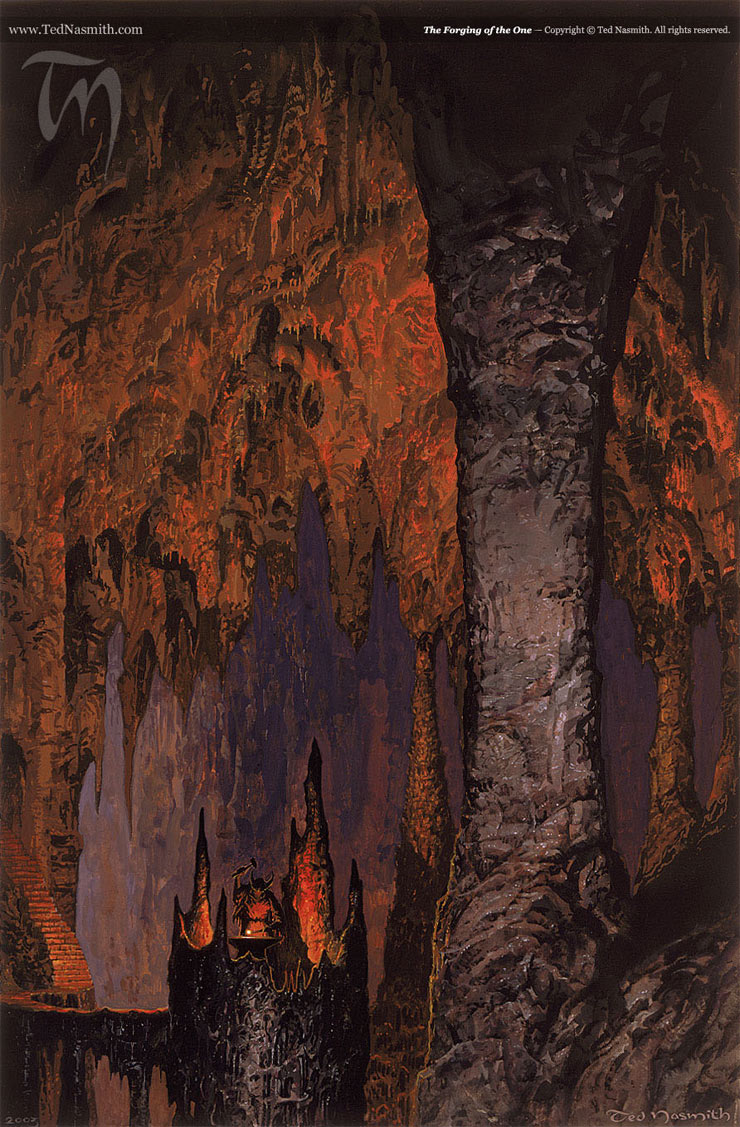
Enter at last the One Ring. The Ruling Ring. The One Ring That’ll Totally Rule Them All, if Sauron has anything to say about it! The year is now 1600, and not only is the Master-ring all set to be the world’s greatest problem, it is the spiritual keystone of Barad-dûr itself. And the Dark Tower’s construction is a wrap. Sauron probably hosted a lovely ribbon-cutting ceremony to announce to the world that the Dark Tower was open for business!
When Sauron places the One Ring upon his finger for the very first time the Elves, thousands of miles away, see right through the ruse for what it was. Annatar is… *gasp!* Sauron the Deceiver! A footnote of Christopher Tolkien’s in Unfinished Tales confirms this:
although the name Sauron is used earlier than this in the Tale of Years, his name, implying identity with the great lieutenant of Morgoth in The Silmarillion, was not actually known until about the year 1600 of the Second Age, the time of the forging of the One Ring. The mysterious power of hostility, to Elves and Edain, was perceived soon after the year 500
Anyway, the Rings of Power are all bad news now; they’re riddled with malware! Ugh, the Elves should have destroyed them; they can see that now. Should have listened to Gil-galad and Elrond (and almost certainly Galadriel). With these Trojan viruses in place, Sauron can perceive “all the things that were done by means of the lesser rings, and he could see and govern the very thoughts of those that wore them.”
So…they just take them off. Elves are rather sensitive to being controlled. Sauron’s not the boss of them! And hey, look how long it took—and how scattered and messy it was—just to get the three kindreds of the Eldar over to Valinor all those millennia ago. If the Valar themselves couldn’t manage the Firstborn so easily, surely one rogue Maia, albeit a very powerful one, isn’t going to pull it off without a hitch. And of course, the Three Rings that Celebrimbor made by himself aren’t just hidden, they’re sent away, in the secret safekeeping of their new owners. No, they weren’t forged by Sauron or even at his behest, but they did use some of the same specs as those earlier ones. They’re still “subject to the One.” Way too risky to even wear them.
So Sauron’s ring-based pyramid scheme didn’t exactly work as it was supposed to. The Noldor, wearing all those Rings of Power, were supposed to fall right under his dominion and not even know it. But the jig is up, and so Sauron is PISSED. How dare those freakin’ Elves not be instantly subjugated by his awesome power! Oh, how he hates them! He’ll get those miserables Elves if it’s the last thing he ever does!
It takes some time to fully prepare—ninety-plus years, actually—but Sauron brings open war against them. Not only does he want to punish them for resisting his insidious plot, he wants his goddamned rings back. All of them. The sixteen, and also those three fancy ones they had the nerve to make behind his back. From Mordor to Eriador, Sauron’s armies pour forth and overwhelm Elven lands.
Only two years into the war, Celebrimbor is seized by the Dark Lord. The text is mercifully brief on that point, but Unfinished Tales offers some grisly details. Celeborn and Elrond each lead a force of Elves and together they stave off Sauron’s army for a time. But it’s not enough. Sauron takes Eregion’s capital city and Celebrimbor personally stands defiant within the halls of the House of the Mírdain (i.e. his jewel-smiths’ clubhouse). He is taken prisoner while the place is thoroughly plundered. Sauron claims nine of the Rings of Power then tortures Celebrimbor and pries from him the whereabouts of seven more. But of those remaining Three—those resplendent elemental rings so dear to the Elf’s heart—Sauron can get nothing. Therefore Celebrimbor is taken out of the picture.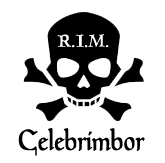
And not just executed. Sauron’s not quite done with him:
In black anger he turned back to battle; and bearing as a banner of Celebrimbor’s body hung upon a pole, shot through with Orc-arrows, he turned upon the forces of Elrond.
Yep. Pincushion Elf on a stick.
At this point, Elrond’s paltry army would have been creamed, but Dwarves come charging out of Khazad-dûm (Moria), hacking their way into the exposed rear of Sauron’s forces. This allows Elrond’s smaller force to escape with their lives. With the Dwarves are Elves from the forest-realm that’ll be properly known as Lothlórien someday. And yeah, a force of Elves must have marched through the halls of their Dwarven friends to get there—how cool is that? All this comes up in Unfinished Tales, and it’s also clear that by this point in time, Galadriel herself has already settled in future-Lothlórien, though she is not yet its ruler. Celeborn hasn’t joined his wife there yet, in part because he hasn’t passed through Moria. See, he still harbors a grudge, remembering that one time millennia ago when Dwarves attacked his homeland (Doriath) and slew his king (Thingol). But still, Galadriel gets along with the Dwarves and seems to have been instrumental in the Elf-Dwarf friendship in the Second Age.
But I digress.
Sadly, this assault against Sauron’s rear by the Dwarves also marks the end of these “happier times.” When the Dark Lord turns in wrath against them, they retreat and shut their doors against him. They are done with this whole Sauron vs. Elf nonsense. Well, almost.
Eregion is torn up big-time in this war, forcing its refugees to flee either west to Lindon or east with Elrond. Loremaster that he is, Elrond finds a well-hidden valley right up against the Misty Mountains. There he founds Imladris, a secret refuge beside the River Bruinen.
Yay, Rivendell is now on the map!
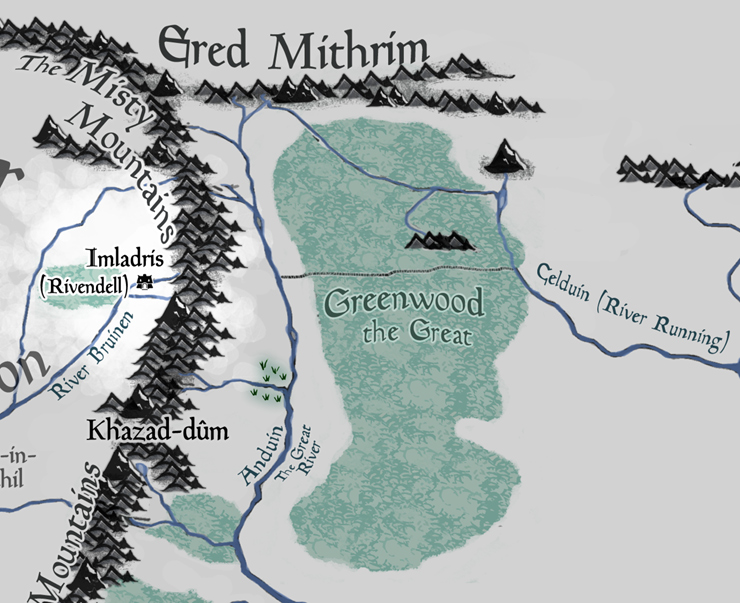
Sauron’s armies continue to go after Gil-galad and Lindon, pushing westward…and that’s when the Númenoreans show up at last. Remember them? This is during the reign of Tar-Minastir, one of the last monarchs of the Dúnedain before things really go pear-shaped there across the Great Sea. But so strong are the Númenóreans that they drive Sauron back out of Eriador altogether. And he accepts that temporary defeat, withdrawing back to Mordor and the East, consolidating his power and cursing Númenor. At this point, Sauron really ought to start a hate list of his own.
During this downtime, he also sets about redistributing the Rings of Power. By now he’s got all sixteen of them in his possession and he aims to see this long con through to the end, even if he’s got to settle for lesser marks. So through various wiles and acts of seduction, he gets them into the hands of both Men and Dwarves; they, at least, should be easier to control. And he doesn’t just leave the rings lying by the highway for unsuspecting fools to find. Nope, he specifically chooses “those that desired secret power beyond the measure of their kind,” since they make perfect stooges. And screw those good-for-nothing Elves; there’s no chance they’d take any rings from him ever again. Useless!
Sauron makes sure seven fall into the hands of some “Dwarf-lords in their halls of stone.” But damn it all to the Void if Aulë’s runtish, half-baked, half-witted, and homespun people aren’t instantly dominated by Sauron’s Ruling Ring when they wear them. What the hell? Turns out they’re too damned tough and way too stubborn to be governed. Still, the Seven Rings increase the Dwarves’ lust for gold and will lead their kingdoms into evil choices which will, in time, benefit Sauron. Some will end up fighting on his side in later conflicts.
And the remaining nine Rings of Power?
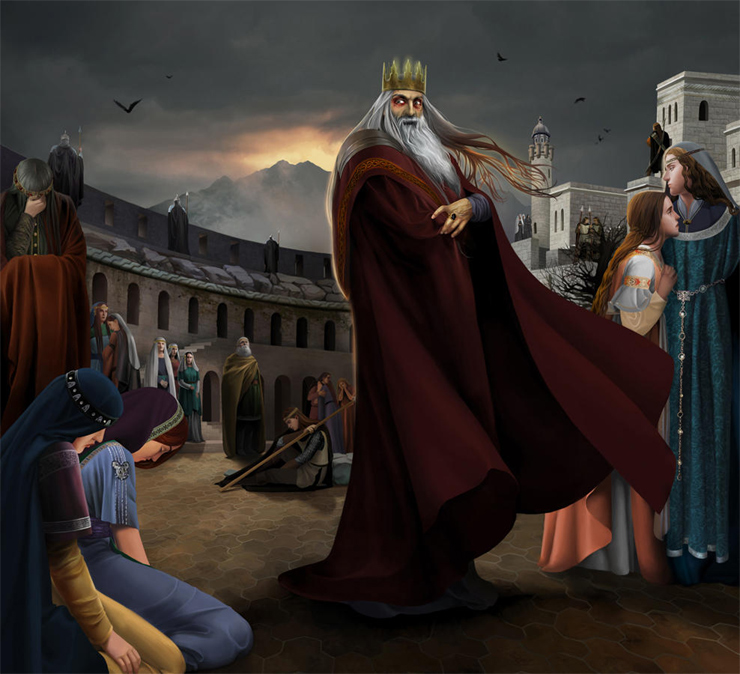
Well, as we all know, those go to “Mortal Men doomed to die,” three of whom are perfect marks: immortality-seeking Númenóreans, likely seduced by Sauron from among those living in havens along the coast. And Unfinished Tales tells us that at least one of the nine is an Easterling named Khamûl. And we don’t get much more than that. Probably one of them collected stamps, and maybe one was named Steve or something. Mere speculation on my part.
These power-hungry souls are utterly ensnared by the Nine through the One that pollutes them. They get power all right, becoming great “kings, sorcerers, and warriors of old,” but in turn their lives are merely extended, tortured, afflicted with Sauron’s own nightmarish phantoms. Not only are their wills dominated, as intended, but they become, in time, his Ringwraiths. Despite the whole “doomed to die” thing, the Nazgûl should be so lucky. Sauron doesn’t let them die, though they “cried with the voices of death.” Make no mistake: The creepy Nazgûl we come to know and love in The Lord of the Rings are powerful and scary, but they are not happy campers. And by the time Frodo meets them, they’ve been enduring unbearable torment for 4,000+ years.
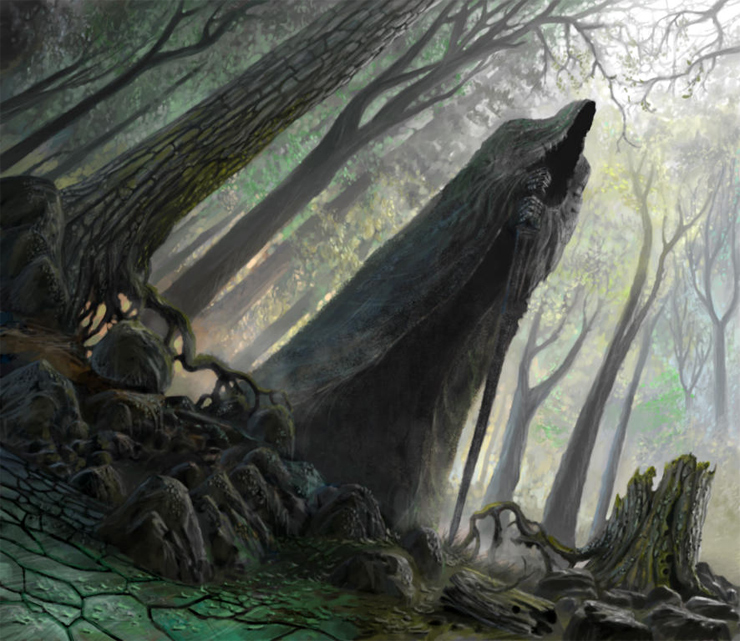
Sauron spends the next thousand years or so consolidating his power, gathering his might, and making himself an overarching menace on Middle-earth. These are the so-called Dark Years, the Black Years, or Days of Flight, during which time a lot more Elves call it quits, make for the Grey Havens, and sail the Straight Road off these mortals lands. Also, Sauron gets some new monikers. The label of Dark Lord is firmly attributed to him at this point, as well as the Enemy—a name the Wise use a lot in The Lord of the Rings. He calls himself the Lord of the Earth, which is a ballsy statement indeed from a former Maia of Aulë. But Sauron has long been assuming that the Valar are done coming over to Middle-earth, so he’s gotten cocky.
Now here’s something we only get from The Return of the King: Among the scattered people of Eriador are the ancestors of the Men who will later be called the Dunlendings. They’re the “wild men,” the plains-dwelling people who are themselves from the same branch of humanity that yielded the Haladin (remember the House of Haleth?). Well, there’s a tribe of these Dunlendish folk called simply the Men of the Mountains living in the hills and holes of the White Mountains—that mountain range west of Mordor. Why am I mentioning this group? Well, we’ll come back to them, but for now it’s worth remembering that during the Dark Years, they actually worship Sauron as a god.
Yeah…he’s really got Men, in general, under his boot.
Yet those Men of Númenor are cramping his style. They keep pushing all his assets off the coasts, posing a serious threat to all his investments, especially if they decide to persist inland. They’re building havens and fortifying new towers and strongholds. They’re a problem. It’s time Sauron diversifies his portfolio, so he now declares himself the King of Men—well, why not, he seems to rule over the rest of them with impunity anyway—but that gets the attention of their twenty-fifth king, Ar-Pharazôn the Golden.
What happens next is Sauron changes gears, adopts his fair form again, but this time goes as himself to meet Ar-Pharazôn’s demand for fealty. He leaves behind his Black Land, his Dark Tower, his Ringwraiths, his Orcs, and all his Men—they should be fine without him for a while—and goes in shackles to Númenor. And, of course, he wrecks things from within. Things go swimmingly, and the Men of Westernesse are brought to ruin. As intended, as he’d hoped. The King of Men, indeed. Awesome.
But looking back, for all he gained, Sauron’s overseas vacation has had some unforeseen consequences. A post-mortem of Project Wreck Númenor might look something like this.
- All right, so Ilúvatar overreacted. Changed the whole “fashion” of the world! Well, damn. Arda’s become a proper planet, a bunch of stuff sank, and now all the seas are connected. No big loss, though. Mordor’s fine. It’s not like Sauron was ever going to be a mariner….
- Sauron’s body got swallowed up and obliterated in that cataclysmic abyss. That literally sucked for him. He lost the ability to assume a deceiving shape ever again, was forced to fly back like a Pac-man ghost to respawn in Mordor. But he’s still got his Ruling Ring, and he can still adopt his scary-ass Dark Lord shape.
- During his fifty-seven-year absence, the might of Gil-galad and his meddling Elves grew exponentially. Oh, sure, now Elves do something fast?! Huge swaths of Middle-earth are no longer fully cowed by the threat of Mordor. From Gil-galad’s seat in Lindon, all across Eriador, over the goddamn Misty Mountains, and right up to the borders of that big forest, Greenwood the Great, the Elves and their allies are doing okay. He can’t leave Mordor alone for five goddamn minutes without all Middle-earth going to pot.
The bottom line is, they all need to be punished for this:
Then Sauron withdrew to his fortress in the Black Land and meditated war.
And then it also turns out some of those pesky Númenóreans survived the great downfall. Maybe they’re too few to be a problem? Only nine ships made it out, after all….
But nope. The Númenóreans that did survive their sinking island are a stubborn, determined, and defiant-as-hell lot. They’re the so-called Faithful of the Dúnedain, and they’re led by Elendil the Tall and his sons, Isildur and Anárion. Heirs of the House of Elros, the first king of Númenor, who was Elrond’s brother. Back on Númenor, Sauron knew about and hated these guys; he’d even tried to have them captured and sacrificed in his evil Temple, but the sons of bitches had slipped through his fingers.
So while Sauron ruminates on war and grows his military even more, Elendil and his sons get organized impressively fast. Within a year of being essentially shipwrecked on the shores of Middle-earth, they join with those Faithful already living in their havens (such as Pelargir), reconnect with Gil-galad and the Elves, and establish two new kingdoms! Sure, it’ll take many decades to really break them in and lose that new kingdom smell, to raise up towers and cities, not to mention multiply their people, and all under duress. But these are still Men of Númenor doing the ordering. This is their bag; they’re good at this stuff.
Together these two kingdoms are later referred to as the Realms in Exile as a sort of nod to Númenor…
Elendil establishes his realm, Arnor, a.k.a. the Northern Kingdom, and it basically stretches across Eriador between the River Lune and the River Bruinen (between the Grey Havens and Rivendell). The capital city is called Annúminas and it includes cities like Fornost and trade settlements like the one that will one day become Bree—not to mention the fertile hills that will become the Shire!
Elendil’s boys, meanwhile, found the Southern Kingdom of Gondor, which right from the get-go is flushed right up against the mountain border of Mordor itself. It includes the White Mountains, a bunch of valleys and rivers and hilly landscapes. Osgiliath becomes Gondor’s capital city, straddling the Great River of Anduin, and that’s where both Isildur and Anárion rule as brotherly kings.
On the east side of the river is raised Minas Ithil, the Tower of the Moon, “as a threat to Mordor,” i.e. a “We’ve got eyes on you, pal.” On the west side of the river and also placed right up against a mountain, is Minas Anor, the Tower of the Setting Sun. While the brothers keep their thrones in Osgiliath, each actually lives in one of these tower-cities; Isildur sets up in Minas Ithil and Anárion in Minas Anor.
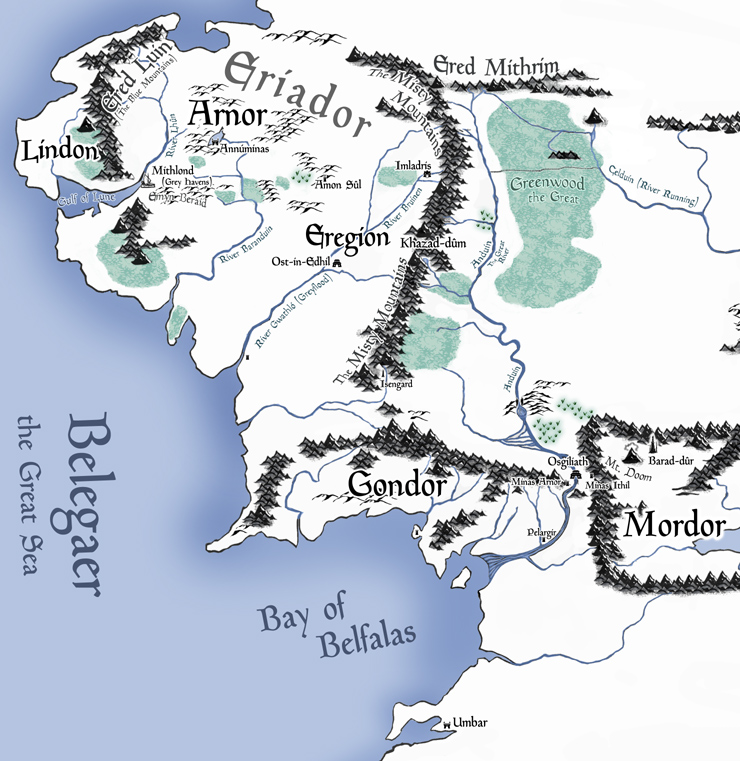
Two other very notable locations come up during this shoring-up of the Dúnedain phase of the Second Age. One is the gates of Argonath, those huge statues of Isildur and Anárion perched on either side of the River Anduin. You know the ones: those kingly sentinels guarding the border of Gondor, each with an arm outstretched and each conveying quite clearly that Mordor and its allies should very definitely talk to the hand. Well, maybe. In the Appendices of The Lord of the Rings it’s also said that they were constructed by the nineteenth king of Gondor in the Third Age. So, err, maybe their foundations began in the Second Age, long after the deaths of the kings they depicted, and maybe in Isildur and Anárion’s day they were just riverside watchtowers?
The second notable location is the circle of Angrenost, better known among Men as Isengard! This marks another part of the border of Gondor, and in the centerpiece of said circular architecture is erected the black “unbreakable stone” tower of Orthanc. It was just a watchtower that happens to be made by Númenóreans who just happen to be OMG-amazing-at-building things.
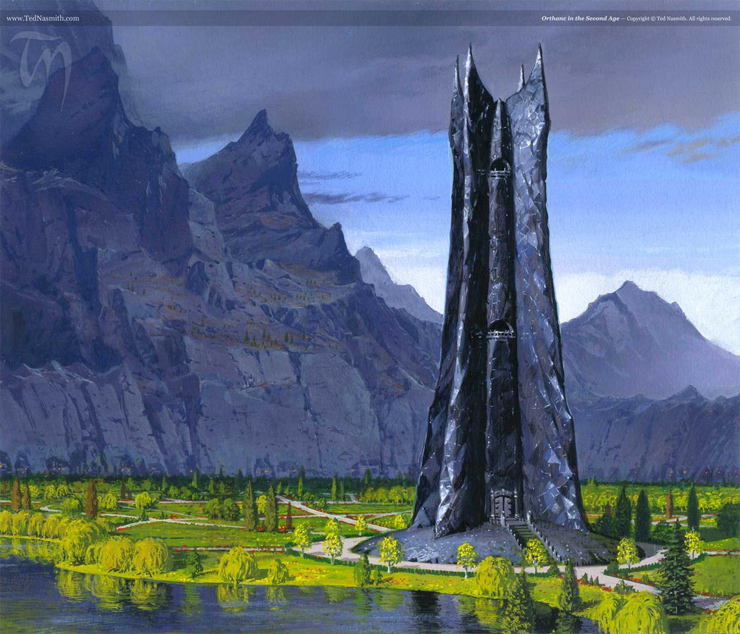
Also, unbreakable stone!? Damn, even their masons are the best of the best. Someday even Ents and their thrown rocks won’t do more than scratch and chip off little flakes of this black stone.
Now, Tolkien just name-drops these badass locations and moves on with a tantalizing lack of detail. And then comes the frosting on this historical Gondorian cake: the palantíri, which the Faithful carried on their ships out of Númenor. They’re among the greatest gifts ever received from the Elves, there are seven of them, and they’re totally all accounted for.
Elendil keeps three and each of his sons gets two (no fighting over the Seeing-stones, kids!). So where do they go? They’re placed in strategically important places so the lords of both Arnor and Gondor can keep an eye on things and stay in touch. They’re either in cities or hills with towers on them (in Sindarin, amon means “hill” and emyn is a cluster of hills).
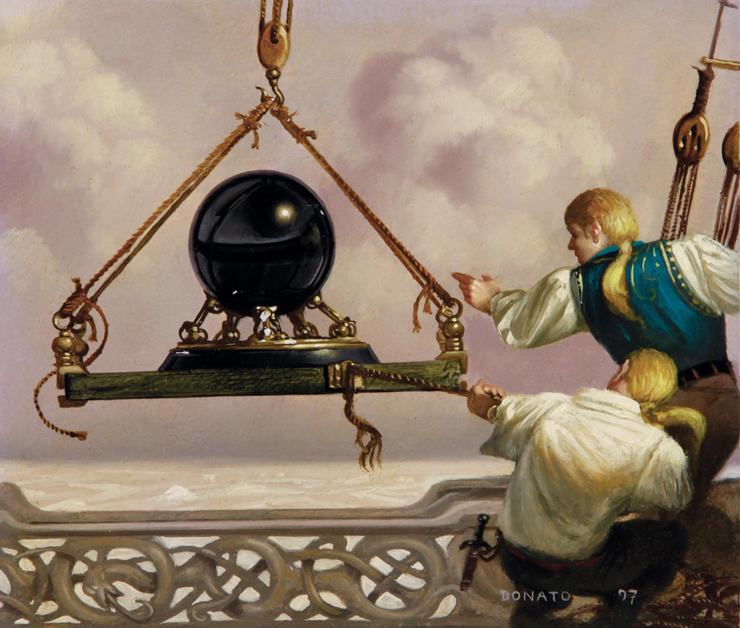
According to Unfinished Tales, they appear “at rest to be made of solid glass or crystal deep black in hue.” Most are about a foot in diameter, but two of them are enormous and can’t be carried by just one guy.
So where to put these?
In Arnor, one goes to the capital city of Annúminas; one goes to Emyn Beraid (the Tower Hills near the Grey Havens); and one enormous one goes to Amon Sûl (a.k.a. Weathertop). In Gondor, one goes to Minas Ithil; one goes to Minas Anor; one goes to Orthanc; and one big one is placed at Osgiliath. Best to visualize it on the map.
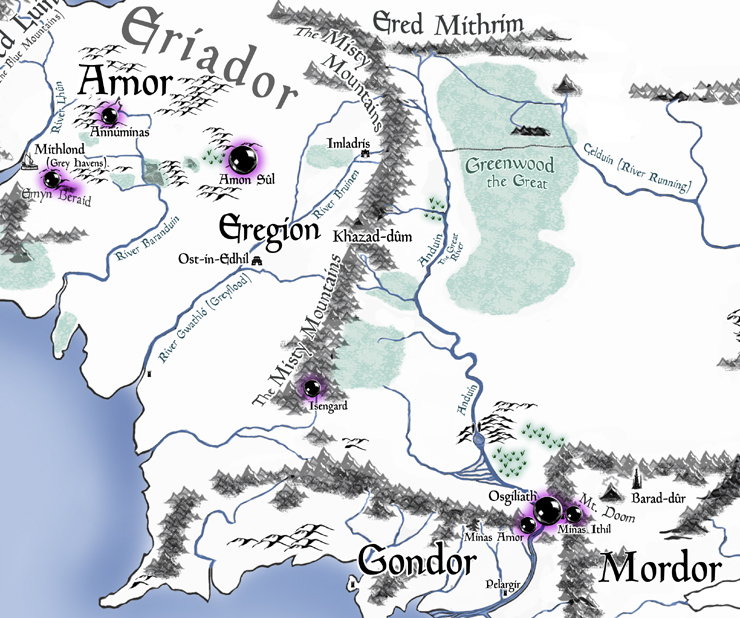
There’s also another giant black stone Isildur brought out of Númenor—dang, their ships must have been really impressive to carry all this heavy cargo, right? Anyway, this one’s not a palantír or anything, just a big smooth rock called the Stone of Erech. It gets placed on a hilltop near the White Mountains as a symbol of Isildur’s lineage. Sort of like planting a flag, I guess, but way more enduring. Not to mention creepier…
And so this is a good time to recall those Men of the Mountains who’d been worshipping Sauron during the Dark Years. In the early days of Gondor, Isildur makes contact with them, offering friendship, not violence. And I guess he wins them over with his charismatic self, because they renounce their service to Sauron and give fealty instead this bold Númenorean king who purports to defend all lands from the Dark Lord. Maybe they never liked Sauron—they just feared him. Well, their king swears allegiance now to Isildur. Therefore standing before the Stone of Erech, that big black Númenorean stone, the Men of the Mountains therefore make an oath….
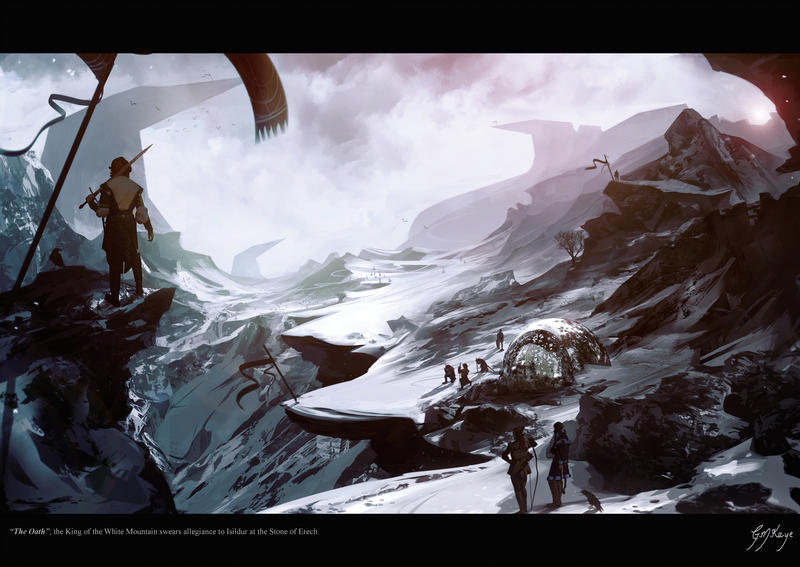
And what’s the oath that they’ll surely never break? If true war ever breaks out between Gondor and Mordor, the Men of the Mountain will fight with Gondor! Cool, cool. Good to know Gondor’s got some more friends in their corner.
And oh yes, there’s one more very important thing the Númenoreans brought with them into their exile from out of Westernesse. The White Tree! Isildur had saved a sapling from the ruin of Númenor, and now he plants it in front of his own house in the tower of Minas Ithil.
Finally, we can just watch these trees just grow.
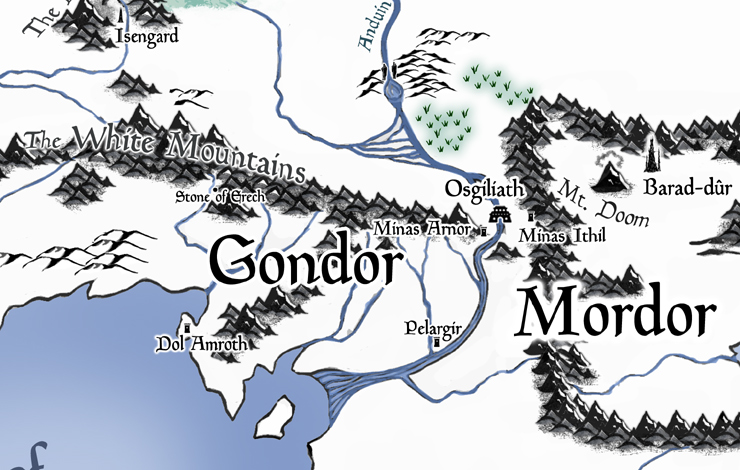
No, wait. We can’t. One day, Sauron is finally ready for fisticuffs. He picks a day in the year 3429 and leads a great assault against this burgeoning kingdom at the edge of his property. This is Gondor’s first real test as a shield against the Enemy! And it…doesn’t go so well for the good guys. Sauron’s forces overtake Minas Ithil and burn the White Tree—these poor trees! Like his master before him, Sauron’s always gunning for trees! Isildur is there to fight till he’s forced to retreat, but not before he manages to scoop up a bit of the White Tree (yes, again!). With his wife, their kids, and their little pet seedling they sail up the Anduin.
Meanwhile his brother launches his own forces out of Osgiliath and drives Sauron’s back into the mountains—basically just holding the Dark Lord at bay for as long as he can. Sauron is way too tenacious to stay put, though. Gondor, strong as it is with its Númenórean lords, still isn’t going to be enough to keep a lid on Mordor.
And thus Elendil and Gil-galad put their heads together and decided they’ve got to combine all their forces and throw everything they’ve got against Sauron—or else he’ll keep doing this, gnawing at each and every realm one at a time. It’s time to put all the eggs in the basket and gang up on the bully. Together they’ll break the power of the Dark Lord, or they won’t and everyone will die. This might as well be it.
Thus the legendary Last Alliance is made, when Elves and Men start gathering in unprecedented numbers (for this age, anyway), picking up steam as it worked its way from Lindon across Eriador before stopping for tea at Rivendell. And by this point the host is “fairer and more splendid in arms than any that has since been seen in Middle-earth, and none greater has been mustered since the host of the Valar went against Thangorodrim.” Which is really saying something, given that the good guys in the War of Wrath consisted of a plethora of Calaquendi Elves, Maiar, and maybe even some Valar. This army is no joke, and Sauron totally deserves what’s coming to him. Oh, and Elrond is now officially marching along as Gil-galad’s herald. They even got Círdan to come, too!
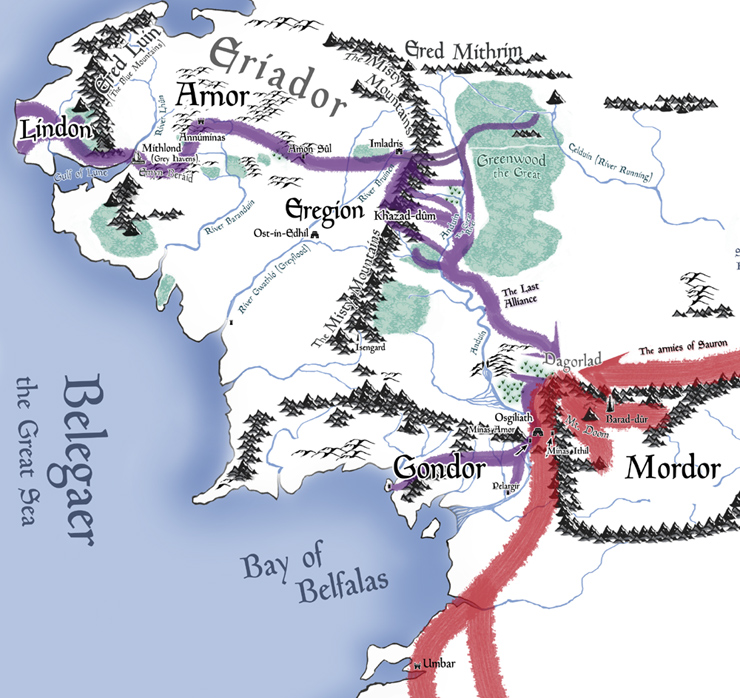
And by the way, Dwarves do join in, and on both sides. Not nearly as many as the Firstborn and Secondborn Children of Ilúvatar, of course, but when the Last Alliance crosses the Misty Mountains, the Dwarves of Khazad-dûm march with them.
With war finally upon them, Isildur goes out to the Stone of Erech and summons the Men of the Mountain to fulfill their oath. To come and join the Last Alliance. This is the moment of truth, guys! To war! And…then they refuse, and I think all Lord of the Rings readers know where this is going. The future Dead Men of Dunharrow flake out big time, and Isildur is rightfully pissed about it. According to Aragorn, Isildur says this to their king:
‘Thou shalt be the last king. And if the West prove mightier than the Black Master, this curse I lay upon thee and thy folk: to rest never until your oath is fulfilled. For this war will last through years uncounted, and you shall be summoned once again ere the end.’
Well, at least the Men of the Mountains don’t come out and fight on Sauron’s side. Isildur has thoroughly intimidated them. These oathbreakers instead withdraw into their mountain homes, becoming the world’s creepiest shut-ins among Men. Isildur can’t be bothered with fair-weather friends now. Battle is nigh.
And so five years after Mordor attacked Gondor, the host of the Last Alliance now meets Sauron’s armies on a great plain just outside of Mordor’s gates. This place will become known as Dagorlad, the Battle Plain. The Elves of Eriador and all their friends, and Arnor, and Gondor, and the Dwarves of Khazad-dûm, and apparently a whole lot of animals, too! It’s a titanic conflict that probably makes the Battle of Five Armies look like a tavern brawl because…
all living things were divided in that day, and some of every kind, even of beasts and birds, were found in either host, save the Elves only. They alone were undivided and followed Gil-galad. Of the Dwarves few fought upon either side; but the kindred of Durin of Moria fought against Sauron.
All right, so maybe there’s some hyperbole there. All living things would imply battle snails, armored ostriches, and attack armadillos. But still, we get that beasts and birds are in the mix, which is fascinating. Certainly that’s got to mean wolves and wargs on Sauron’s side, but what else!? Lions? Emus?! I desperately want to know, but it’s not Tolkien’s style to give us those details, so we must move on.
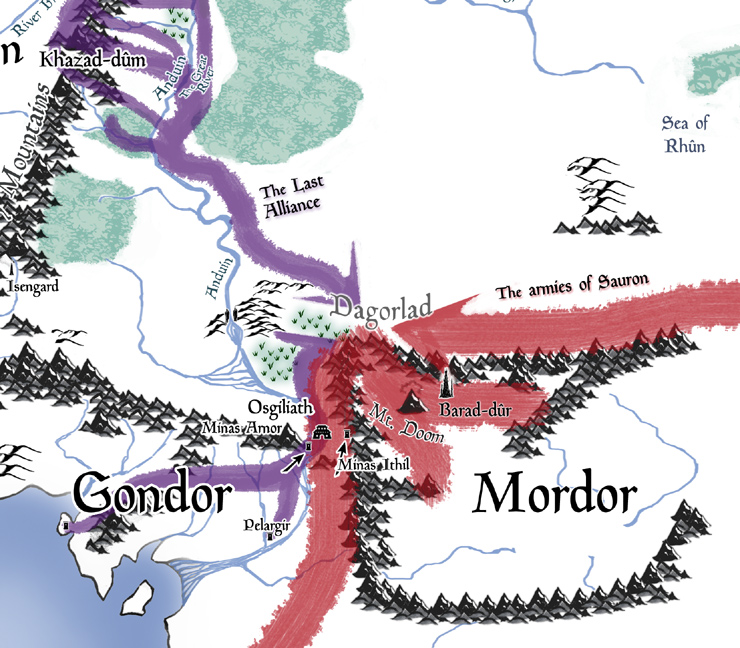
Now, Sauron’s got his Orcs, of course, but craploads of Men, too—including Black Númenóreans and Haradrim, Men of the South also under the Enemy’s sway. And maybe Easterlings. The great battle is devastating all around, and whole armies of good Men and Elves are slain along with the Orcs. Remember the Dead Marshes, which are adjacent to this plain? Many are driven to their end there. As Gollum describes it later, recalling his tales when he was just a young Sméagol:
It was a great battle. Tall Men with long swords, and terrible Elves, and Orcses shrieking. They fought on the plain for days and months at the Black Gates. But the Marshes have grown since then, swallowed up the graves; always creeping, creeping.
But in the end Gil-galad and Elendil take the win and push right through the Black Gates, into the Black Land, and right up to the Black Lord’s base. In the valley of Gorgoroth, a true siege begins and it lasts for seven years. Seven! That’s a long time for Men, Elves, Dwarves, and their friends to be hanging out inside Mordor where the shadows lie. So we’re talking encampments, sorties, supply trains, and setbacks. For seven years the Last Alliance and Sauron’s armies give it all they’ve got, while the Dark Lord himself stays holed up safely inside Barad-dûr. And during this time many are killed, including Anárion, Isildur’s little brother.
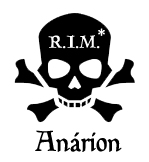
Yet the Last Alliance is unshakable, and it forces the Dark Lord to come out in person at last. Unwilling to settle this through another epic sing-off, he ends up physically tangling with the two commanders of his besiegers right there, at the foot of his workshop, Mount Doom.
Thus this ancient evil Maia squares off with the mortal Elendil and the elf-king Gil-galad. All three combatants are still mighty. Elendil is called the Tall for a reason, by the way. According to Unfinished Tales, he’s nearly eight feet high. Dude’s a giant, and he wields Narsil, which glows with both moonlight and sunlight, having been forged by the same Dwarf who made Angrist, the knife that cut the Silmaril from Morgoth’s crown! And Gil-galad’s spear is named Aeglos, which means “snow-point,” so it’s got be something like a Spear of Ice and Maia-Skewering +4.
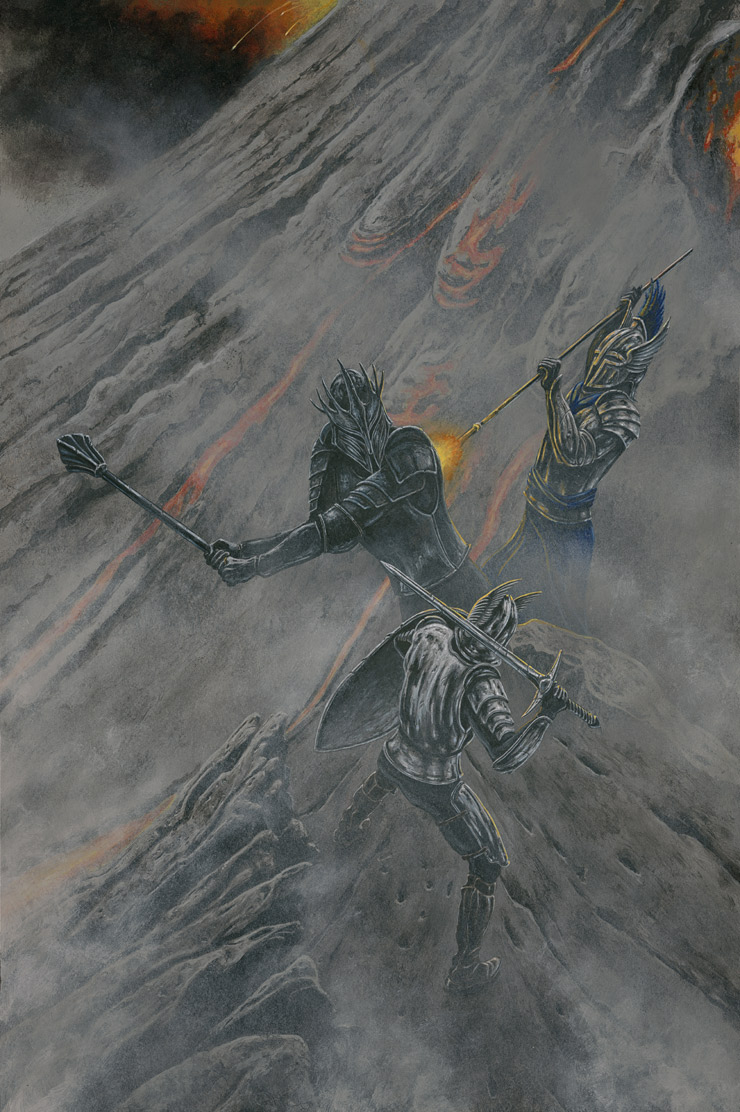
But Sauron is Sauron. Yes, this is the same guy who got smacked around by a girl and her puppy-dog in the First Age (okay, a very special girl and a very special puppy-dog), and nearly had his ghost “sent quaking back to Morgoth,” but he’s overpowered and outsmarted everyone he’s faced before and since. Yet Gil-galad and Elendil take him down at last, though both kings are slain in the process.

This is a fact easy to overlook. With the One Ring still on his finger, Sauron is defeated in hand-to-hand combat by a Númenórean king-in-exile and the last High King of the Noldor. He’s thrown down, and I suppose maybe he could have recovered and stood up again if he’d been left that way, what with the Ring still on his person. But Isildur is there to stop that from happening.
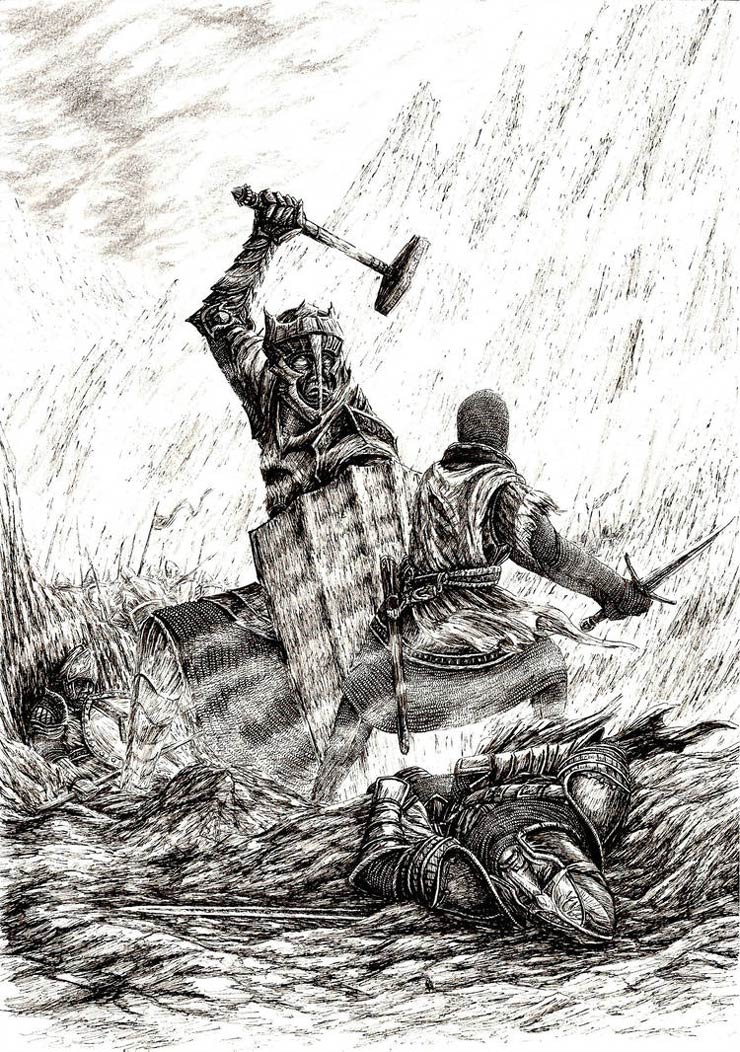
He picks up the hilt of his dad’s broken sword, itself also a casualty of the scuffle, and it’s so well made that the hilt-shard is still sharp enough to accomplish its most famous deed: relieving the Dark Lord of one of his fingers! His Ruling Ring–wearing finger, as it happens. And that seals the deal on the Enemy’s defeat. The loss of his Ring is the finishing touch, as we all know. Sauron’s ghost is now indeed sent quaking the hell out of there, for he’d put so much of his power into that Ring that he simply cannot abide its loss. Not now, anyway. He’s got a deep spiritual wound to nurse.
To all this Círdan and Elrond stand in witness. The loremaster of Rivendell says as much at his namesake Council in The Fellowship of the Ring. And then someone, maybe some Elf really paying attention, calls it: the end of the Second Age! “This seemed like a good point in history to wrap things up,” they probably argue. “New calendars, everyone!”
In the next installment, we’ll come to it at last: the Third Age, the one we all already know and love, where Isildur surely disposes of the One Ring in a safe and timely manner, Arnor and Gondor stay strong, and over in Valinor a Maia named Olórin breathes a sigh of relief. He won’t be needed in Middle-earth, after all. Whew! I mean…I think.
Top image from “The One Ring at Bag End” by Donato Giancola.
Jeff LaSala is now obsessed with that “all living things” line—were there penguins fighting on both sides of the Battle of Dagorlad?! Tolkien geekdom aside, Jeff wrote a Scribe Award–nominated D&D novel, produced some cyberpunk stories, and now works for Tor Books. He sometimes flits about on Twitter.










